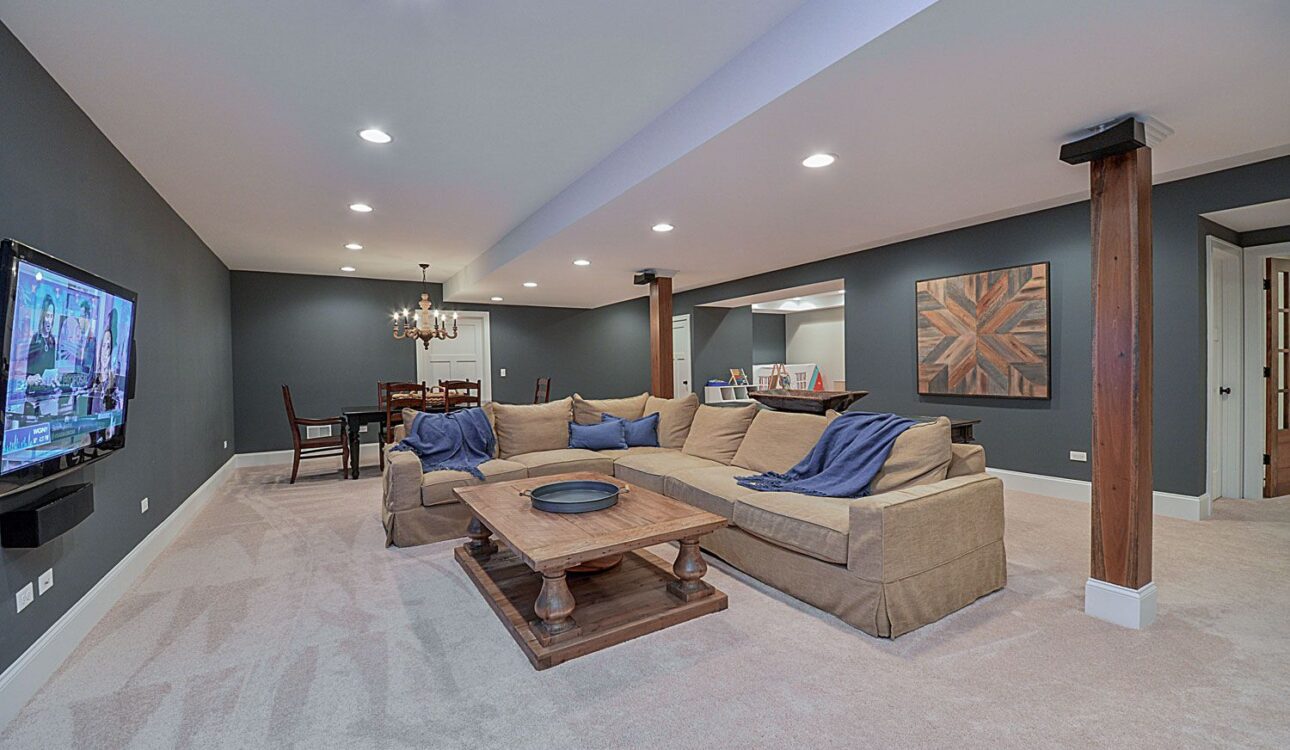Basement remodeling has become one of the most popular home improvement projects for homeowners looking to maximize their living space without the expense of a full home addition. Whether you’re a growing family needing extra room, a remote worker seeking a dedicated home office, or simply looking to increase your property value, transforming your basement into a modern living space offers endless possibilities.
Modern basement renovation goes far beyond the traditional “finished basement” concept. Today’s basement remodeling projects focus on creating sophisticated, comfortable spaces that seamlessly integrate with your home’s overall design aesthetic. From contemporary entertainment areas to cozy family rooms and functional home offices, the potential for basement transformation is limitless.
Planning Your Basement Remodeling Project
Assessing Your Basement’s Potential
Before diving into basement remodeling ideas, it’s crucial to evaluate your space’s current condition and potential. Start by examining the ceiling height – modern basement design typically requires at least 7-8 feet of clearance for comfortable living. Check for any structural issues, existing plumbing or electrical systems, and assess the overall layout possibilities.
Consider your family’s specific needs when planning your basement renovation. Are you looking to create a teen hangout space, a sophisticated entertainment area, or a quiet home office retreat? Understanding your primary goals will guide every decision throughout the remodeling process, from layout design to material selection.
Don’t forget to research local building codes and permit requirements for your basement remodeling project. Many areas have specific regulations regarding ceiling heights, emergency exits, and electrical work that must be addressed before beginning construction.
Setting a Realistic Budget
Modern basement design projects can vary significantly in cost, depending on the scope of work and materials chosen. Establish a realistic budget early in the planning process, typically allocating 10-20% extra for unexpected issues that commonly arise during basement renovation projects.
Consider prioritizing essential elements like moisture control, proper insulation, and electrical upgrades before focusing on aesthetic improvements. These foundational improvements ensure your basement remodeling investment will provide long-term value and comfort.
Research different contractors and get multiple quotes for your basement remodeling project. Look for professionals with specific experience in basement renovations, as they’ll understand the unique challenges and solutions required for below-grade spaces.
Timeline and Project Management
Basement remodeling projects typically take 4-8 weeks, depending on complexity and scope. Plan for potential delays, especially if structural modifications or extensive electrical work is required. Consider how the construction process will impact your daily routine and plan accordingly.
Create a detailed timeline with your contractor, including milestones for major phases like framing, electrical, plumbing, drywall, and finishing work. This helps ensure your basement renovation stays on track and within budget.
Consider seasonal factors when planning your basement remodeling timeline. Spring and fall often provide optimal conditions for construction work, while summer and winter may present challenges with humidity control and material delivery.
Essential Basement Remodeling Ideas for Modern Homes
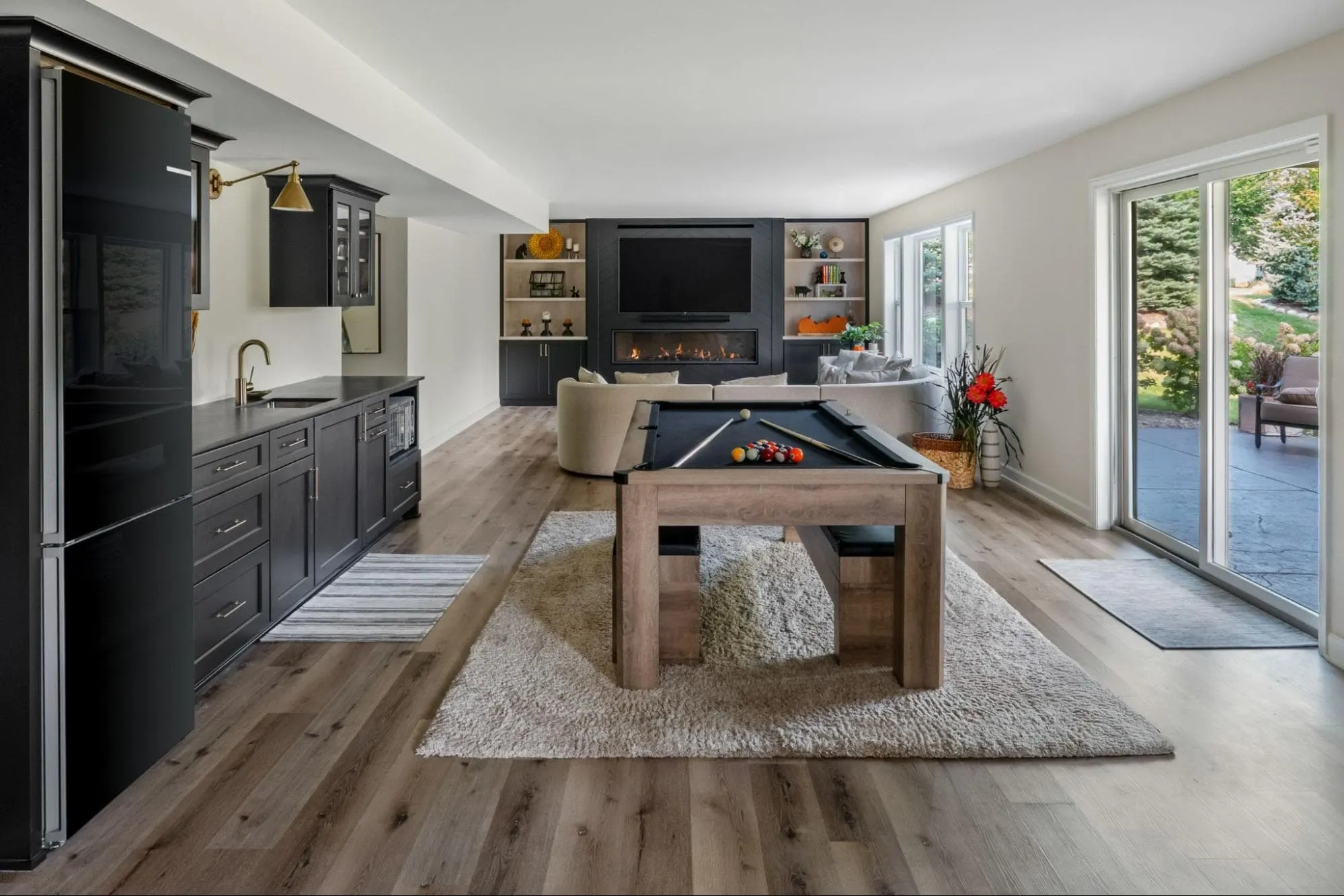
Contemporary Design Elements
Modern basement design embraces clean lines, open concepts, and sophisticated color palettes. Consider incorporating contemporary elements like exposed ceiling beams painted in bold colors, sleek built-in storage solutions, and minimalist furniture arrangements that maximize the feeling of space.
Neutral color schemes work particularly well in basement remodeling projects, as they help reflect available light and create an airy atmosphere. Think warm grays, crisp whites, and natural wood tones that complement your home’s existing aesthetic while creating a cohesive flow between levels.
Industrial touches can add character to modern basement renovations. Consider leaving some mechanical elements exposed but painted in coordinating colors, incorporating metal accents, or using concrete floors with decorative finishes for an urban loft feel.
Creating Zones for Different Activities
Successful basement remodeling often involves creating distinct zones for different activities within the same space. Use furniture arrangement, area rugs, and lighting to define separate areas for entertainment, relaxation, work, and storage without requiring permanent walls.
Consider incorporating a wet bar or kitchenette area in your basement renovation, which adds both functionality and entertainment value. This feature is particularly popular in modern basement design and can significantly increase your home’s resale value.
Think about incorporating technology seamlessly into your basement remodeling project. Plan for adequate electrical outlets, built-in charging stations, and pre-wiring for entertainment systems to ensure your modern basement meets contemporary lifestyle needs.
Maximizing Natural Light
While basements naturally have limited natural light, modern basement design focuses on maximizing whatever light is available. Consider enlarging existing windows, adding window wells, or installing egress windows that serve dual purposes of safety and illumination.
Light-colored finishes and strategic mirror placement can help amplify natural light throughout your basement remodeling project. Consider glossy paint finishes, light-colored flooring, and reflective surfaces that bounce light around the space.
Glass block windows offer an excellent solution for basement renovation projects, providing privacy while allowing natural light to filter through. They’re also excellent for moisture control and security concerns common in basement spaces.
Moisture Control and Waterproofing Solutions
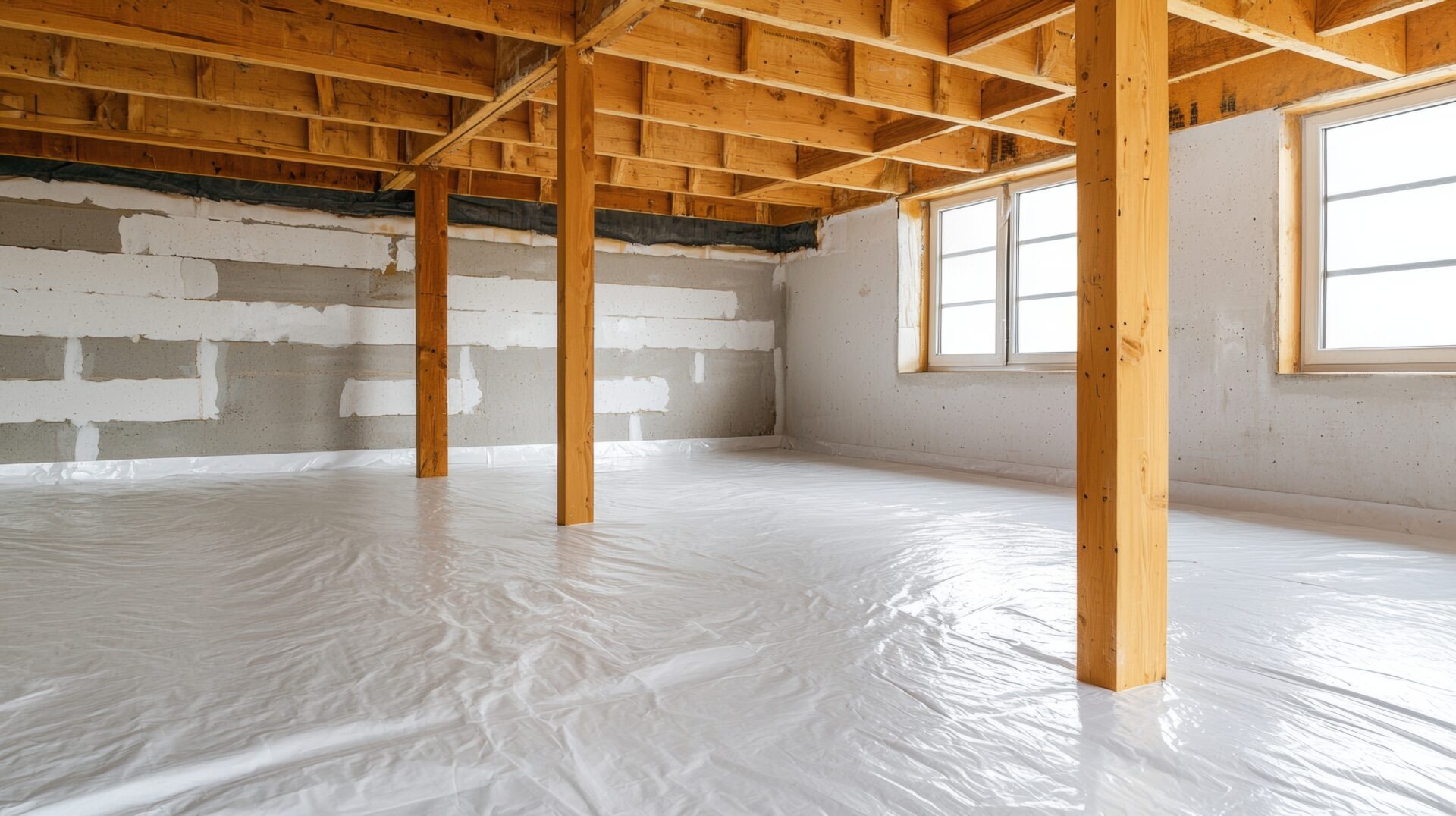
Understanding Basement Moisture Issues
Moisture control is perhaps the most critical aspect of any basement remodeling project. Understanding the sources of moisture – whether from groundwater, condensation, or plumbing leaks – is essential before beginning any renovation work. Proper moisture management ensures your investment in modern basement design will last for years to come.
Common signs of moisture problems include musty odors, visible mold or mildew, water stains on walls or floors, and condensation on pipes or windows. Address these issues before proceeding with your basement renovation to prevent future problems and ensure a healthy living environment.
Professional moisture assessment may be necessary for complex situations. Consider hiring a specialist to evaluate your basement’s specific moisture challenges and recommend appropriate solutions before beginning your remodeling project.
Waterproofing Solutions
Interior waterproofing solutions include sealants, waterproof paints, and interior drainage systems that can be incorporated into your basement remodeling project. These solutions work well for minor moisture issues and can be integrated seamlessly into modern basement design.
Exterior waterproofing, while more expensive, provides comprehensive protection against groundwater infiltration. This approach may be necessary for basements with significant moisture problems and should be completed before interior basement renovation work begins.
Vapor barriers and proper insulation play crucial roles in moisture control during basement remodeling. Ensure your contractor understands the importance of these elements and incorporates them appropriately into your modern basement design.
Ventilation and Air Quality
Proper ventilation is essential for maintaining air quality in your renovated basement space. Consider installing exhaust fans, upgrading your HVAC system to include basement areas, or adding a dehumidifier to maintain optimal humidity levels year-round.
Air circulation becomes even more important in finished basements with multiple activity zones. Plan for adequate air movement throughout your basement remodeling project to prevent stagnant air and moisture buildup in corners or closed areas.
Consider air purification systems as part of your basement renovation, especially if family members have allergies or respiratory sensitivities. Modern basement design can incorporate these systems discretely while maintaining aesthetic appeal.
Lighting Solutions for Basement Renovation
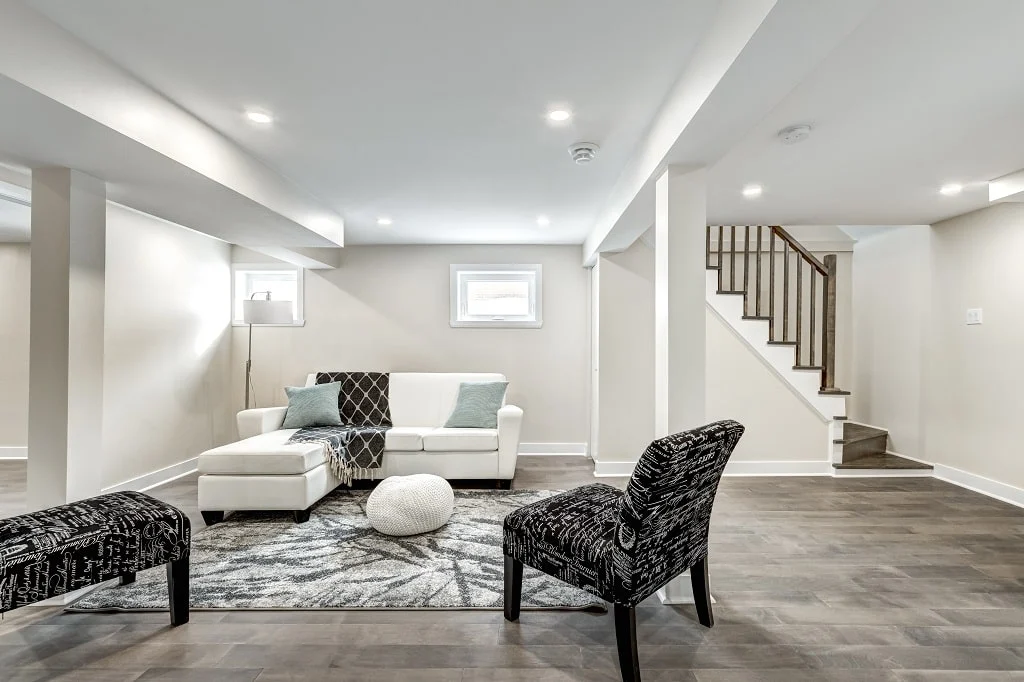
Layered Lighting Design
Modern basement design relies heavily on well-planned artificial lighting to create warmth and functionality. Implement a layered lighting approach that combines ambient, task, and accent lighting to create a welcoming atmosphere that rivals any above-ground living space.
Recessed ceiling lights provide excellent general illumination for basement remodeling projects, especially in areas with lower ceilings. Choose LED fixtures for energy efficiency and longevity, and consider dimmer switches for versatility in different activity zones.
Track lighting offers flexibility in basement renovation projects, allowing you to direct light where needed and adjust as your space usage evolves. This solution works particularly well in multi-functional basements with changing lighting needs.
Task and Accent Lighting
Under-cabinet lighting in basement kitchenettes or work areas provides essential task lighting while adding a modern touch to your basement remodeling project. LED strip lights are particularly effective and can be integrated seamlessly into contemporary design elements.
Table and floor lamps add warmth and personality to modern basement spaces while providing localized lighting for reading, crafts, or relaxation areas. Choose fixtures that complement your overall design aesthetic while providing adequate illumination.
Accent lighting can highlight architectural features, artwork, or built-in storage solutions in your basement renovation. Consider wall sconces, picture lights, or decorative pendant fixtures that add visual interest while serving functional purposes.
Smart Lighting Solutions
Smart lighting systems allow you to control your basement’s ambiance with smartphone apps or voice commands, perfect for modern basement design. These systems can be programmed for different activities, times of day, or entertainment scenarios.
Motion sensors can be particularly useful in basement remodeling projects, automatically illuminating stairways, storage areas, or bathrooms for safety and convenience. Choose sensors with adjustable sensitivity and timing for optimal functionality.
Color-changing LED systems offer endless possibilities for basement renovation projects, allowing you to adjust the mood and atmosphere for different activities or seasons. These systems work particularly well in entertainment areas or teen spaces.
Flooring Options for Modern Basement Design

Waterproof Flooring Solutions
Luxury vinyl plank (LVP) flooring has become increasingly popular in basement remodeling projects due to its waterproof properties, realistic wood appearance, and comfortable underfoot feel. Modern LVP options offer sophisticated designs that complement contemporary basement renovation aesthetics.
Polished concrete floors provide an industrial-chic look perfect for modern basement design while offering excellent moisture resistance. Consider decorative concrete options like staining, stamping, or epoxy coatings to add visual interest and color to your basement remodeling project.
Ceramic and porcelain tiles offer unlimited design possibilities for basement renovation projects, from wood-look planks to contemporary geometric patterns. Choose tiles with appropriate slip resistance ratings for safety in potentially humid basement environments.
Comfort and Insulation Considerations
Subfloor systems can dramatically improve comfort in basement remodeling projects by providing insulation and moisture barriers beneath finished flooring. These systems create a warmer, more comfortable surface while protecting your flooring investment.
Area rugs and carpet tiles offer warmth and comfort in basement renovation projects while allowing for easy replacement if moisture issues occur. Choose moisture-resistant backing materials and consider antimicrobial treatments for added protection.
Radiant floor heating systems can transform the comfort level of your basement remodeling project, providing consistent warmth that makes the space truly livable year-round. These systems work well under most flooring types and add significant value to modern basement design.
Aesthetic and Practical Balance
Consider the traffic patterns and intended use of different areas when selecting flooring for your basement renovation. High-traffic areas may benefit from more durable options, while cozy seating areas might prioritize comfort and warmth.
Transition strips and thoughtful material changes can help define different zones in your basement remodeling project while maintaining visual flow throughout the space. Consider how different flooring materials will work together in your overall design scheme.
Maintenance requirements should factor into your flooring decisions for basement renovation projects. Choose materials that align with your lifestyle and cleaning preferences while meeting the practical demands of below-grade environments.
Space Optimization and Storage Solutions
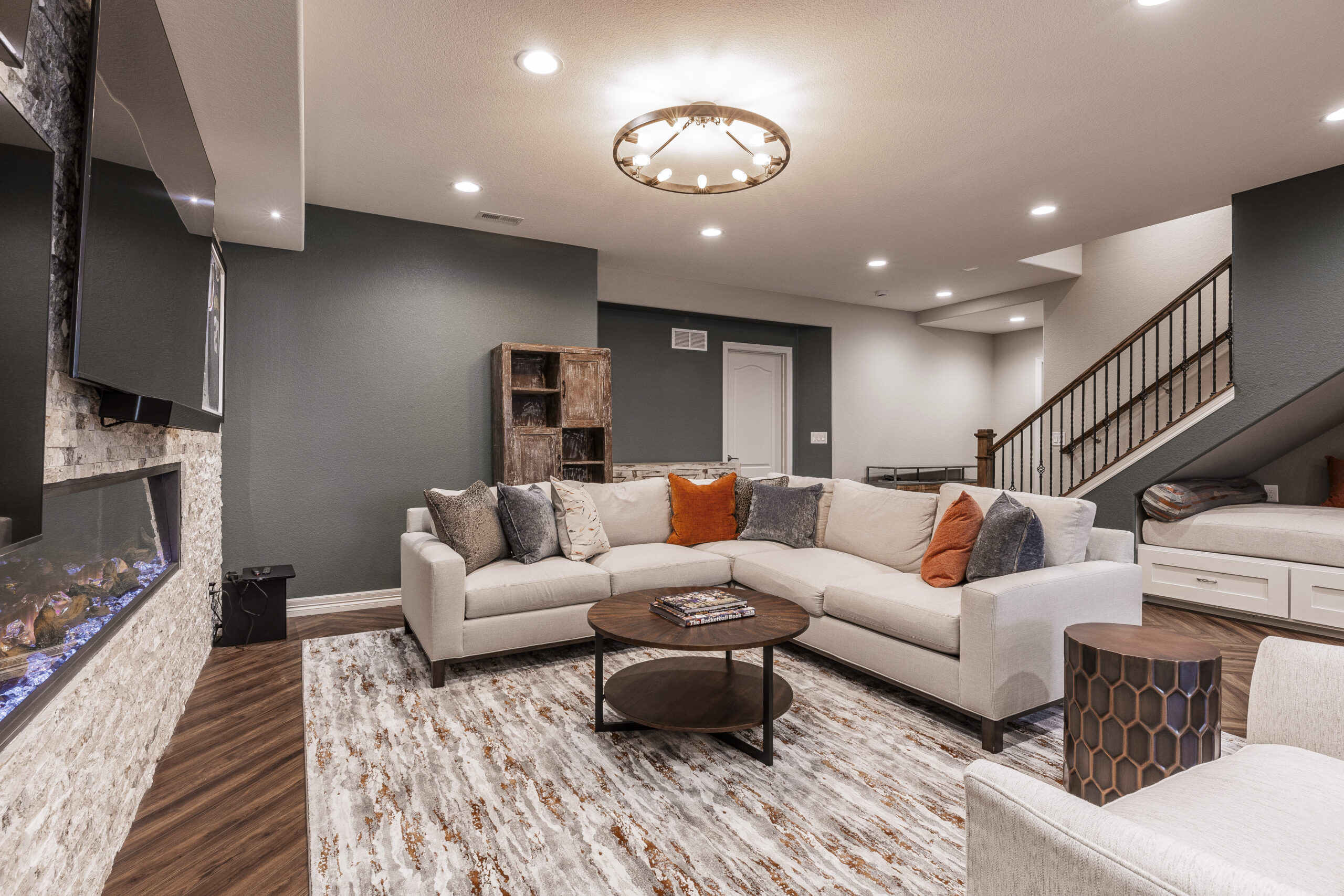
Built-in Storage Solutions
Custom built-in storage maximizes every square foot in basement remodeling projects while maintaining clean, modern lines. Consider floor-to-ceiling shelving units, window seat storage, or built-in entertainment centers that serve multiple functions while minimizing visual clutter.
Under-stair storage represents often-overlooked space in basement renovation projects. Transform this area into a functional closet, wine storage, or organized utility area that keeps necessary items accessible but out of sight in your modern basement design.
Built-in benches with hidden storage provide seating while concealing seasonal items, sports equipment, or household supplies. These solutions work particularly well in basement remodeling projects where space efficiency is paramount.
Multi-Purpose Furniture
Ottoman storage pieces serve as seating, footrests, and storage containers, making them ideal for basement renovation projects where flexibility is key. Choose pieces that complement your modern basement design while providing practical functionality.
Expandable dining tables allow basement spaces to serve multiple functions, from daily homework areas to entertainment spaces for larger gatherings. Look for contemporary designs that fold, extend, or transform to meet changing needs in your basement remodeling project.
Wall-mounted desks and fold-down tables maximize floor space in basement renovation projects while providing functional work surfaces when needed. These solutions work particularly well in basement home offices or craft areas.
Ceiling Height Optimization
Low-profile furniture helps maximize the feeling of space in basement remodeling projects with limited ceiling height. Choose sectional sofas, low coffee tables, and horizontal storage solutions that emphasize width rather than height.
Vertical storage solutions draw the eye upward in basement renovation projects, creating the illusion of higher ceilings. Consider tall, narrow bookcases or vertical wall art arrangements that emphasize the room’s height.
Ceiling treatments can dramatically impact the perceived space in basement remodeling projects. Consider painted exposed joists, decorative ceiling tiles, or strategic lighting placement that minimizes the feeling of a low ceiling in your modern basement design.
Creating Multi-Functional Areas in Your Basement
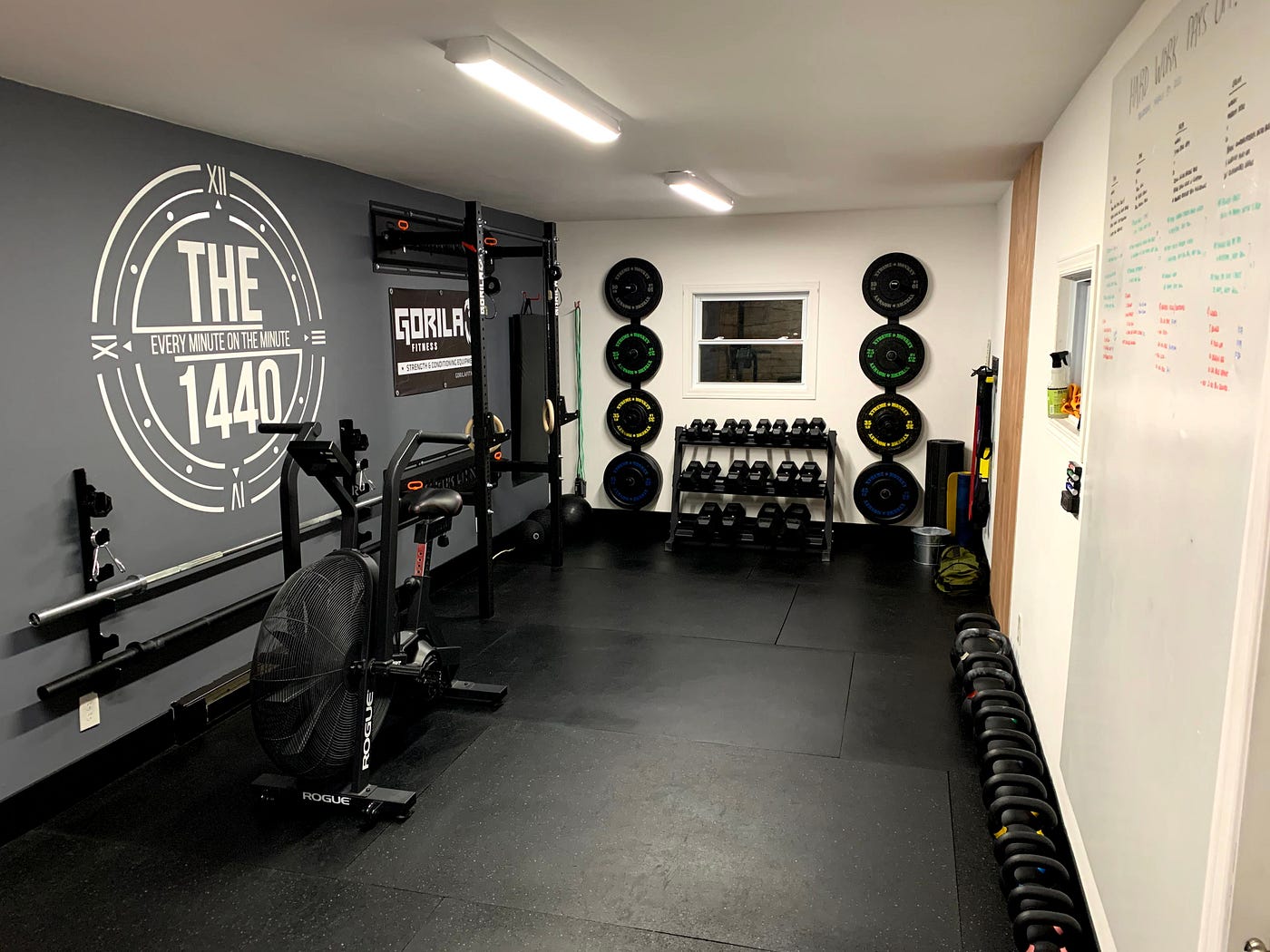
Home Office Integration
Basement home offices have become increasingly popular, offering quiet, dedicated workspace separate from household distractions. Design your basement remodeling project to include proper lighting, ventilation, and electrical outlets necessary for productive work environments.
Consider soundproofing elements in your basement renovation if the office will be used for video calls or meetings. Acoustic panels, carpet, and soft furnishings can help minimize sound transmission while maintaining modern basement design aesthetics.
Ergonomic considerations are crucial for basement home offices, including proper desk height, supportive seating, and adequate lighting to prevent eye strain. Plan these elements carefully during your basement remodeling project to ensure long-term comfort and productivity.
Entertainment and Recreation Areas
Game rooms and entertainment areas are classic basement remodeling applications that benefit from modern design approaches. Consider built-in seating, ambient lighting, and sound systems that create an immersive experience while maintaining sophisticated aesthetics.
Home theaters represent the ultimate basement renovation luxury, requiring careful planning for acoustics, lighting control, and comfortable seating arrangements. Modern basement design can incorporate these elements seamlessly while maintaining overall space functionality.
Exercise areas within basement remodeling projects require specific considerations including ventilation, flooring, and ceiling height. Plan for equipment storage and ensure adequate electrical capacity for modern fitness equipment in your basement renovation.
Guest Accommodation
Basement guest suites maximize your home’s accommodation potential while providing privacy for visitors. Include essential amenities like a bathroom, adequate storage, and emergency egress windows in your basement remodeling project to ensure comfort and safety.
Murphy beds or daybed solutions allow basement spaces to serve multiple functions, transforming from daily-use areas to comfortable guest accommodations when needed. Choose modern designs that integrate seamlessly with your overall basement renovation aesthetic.
Privacy considerations are important for basement guest areas, including sound control between levels and adequate separation from family activity areas. Plan these elements carefully during your basement remodeling project to ensure guest comfort.
Frequently Asked Questions
What permits are required for basement renovation projects?
Most basement remodeling projects require building permits, especially when adding bedrooms, bathrooms, or making structural changes. Electrical and plumbing work typically require separate permits. Check with your local building department early in the planning process to understand specific requirements and ensure your basement renovation meets all safety codes.
How long does a typical basement remodeling project take?
Most basement renovation projects take 4-8 weeks, depending on complexity and scope. Simple finishing projects may take less time, while extensive remodeling including bathrooms, kitchenettes, or structural changes may require longer. Weather, permit approval times, and material availability can also impact your basement remodeling timeline.
What's the best way to prevent moisture problems in finished basements?
Effective moisture control combines proper waterproofing, ventilation, and humidity control. Address exterior drainage issues, install vapor barriers, ensure adequate ventilation, and maintain humidity levels between 30-50%. Professional assessment may be necessary for basements with existing moisture problems before beginning renovation work.
Can any basement be remodeled into living space?
Most basements can be improved, but some factors may limit full living space conversion. Ceiling height (minimum 7 feet recommended), moisture issues, structural problems, and local building codes all impact feasibility. A professional assessment can determine your basement's potential and recommend appropriate renovation approaches for your specific situation.
Ready to Transform Your Basement?
Your basement remodeling project represents an incredible opportunity to add valuable living space, increase your home’s value, and create the modern, functional areas your family needs. From moisture control and lighting solutions to space optimization and contemporary design elements, every aspect of your basement renovation requires careful planning and professional execution.
At Fineline Kitchens, we specialize in transforming basements into beautiful, functional living spaces that exceed our clients’ expectations. Our experienced team understands the unique challenges of basement remodeling and has the expertise to guide you through every step of the process, from initial planning to final finishing touches.
Don’t let your basement remain an underutilized space. Contact us today to schedule your consultation and discover how we can help you create the modern basement living space you’ve always envisioned. Visit our basement remodeling portfolio to see examples of our work, or call us to discuss your specific project needs.
Transform your basement from storage space to your family’s favorite room – contact Fineline Kitchens today and take the first step toward your dream basement renovation!
Source Links
Interior Design and Basement Renovation Resources:
- Better Homes & Gardens – Basement Remodeling Ideas: https://www.bhg.com/rooms/basement/
- This Old House – Basement Finishing Guide: https://www.thisoldhouse.com/basements
- HGTV – Basement Design and Renovation: https://www.hgtv.com/design/rooms/basements
Building Codes and Safety Information:
- International Residential Code (IRC): https://codes.iccsafe.org/
- National Association of Home Builders: https://www.nahb.org/
Moisture Control and Waterproofing:
- Basement Health Association: https://basementhealthassociation.org/
- EPA Indoor Air Quality Guide: https://www.epa.gov/indoor-air-quality-iaq
